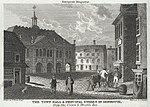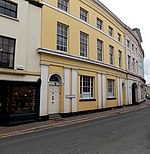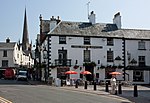Great Castle House

Great Castle House is a former town house built on the site of part of Monmouth Castle in Wales. Amongst the town's most significant buildings, it has a Grade I listing and is one of 24 sites on the Monmouth Heritage Trail. The house is located on Castle Hill, off Agincourt Square in Monmouth town centre. Described as "a house of splendid swagger outside and in", it was completed in 1673 for Henry Somerset, the 3rd Marquis of Worcester, who was Lord President of the Council of Wales and the Marches. It later became an Assize Court, until the Court moved to the new Shire Hall in 1725. It has been the Headquarters of Royal Monmouthshire Royal Engineers (Militia) since the mid-19th century, and contains the Regimental Museum.
Excerpt from the Wikipedia article Great Castle House (License: CC BY-SA 3.0, Authors, Images).Great Castle House
Castle Hill,
Geographical coordinates (GPS) Address External links Nearby Places Show on map
Geographical coordinates (GPS)
| Latitude | Longitude |
|---|---|
| N 51.8127 ° | E -2.7164 ° |
Address
Castle House
Castle Hill
NP25 3BS , Overmonnow
Wales, United Kingdom
Open on Google Maps










